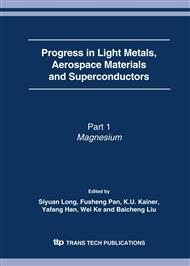p.671
p.675
p.681
p.687
p.691
p.697
p.703
p.707
p.713
Low-Frequency Electromagnetic Field Influencing Horizontal Direct Chill Casting of Aluminum Alloy Rods
Abstract:
The horizontal direct chill (HDC) casting process is a well-established production route for an aluminum alloy ingot; however, the ingot may suffer from inhomogeneous microstructures and serious macrosegregation due to the unbalanced cooling condition and gravitational effect. In order to control the defect, a low frequency electromagnetic field has been applied in the HDC casting process and its influences on microstructures and macrosegregation have been studied. The results show that the low frequency electromagnetic field can improve macrostructures, reduce inhomogeneous microstructures and macrosegregation in HDC product; and two main parameters of the electromagnetic field—density and frequency influence the microstructures and solution distribution along the diameter of the ingot significantly. In the range of ampere-turns and frequency employed in the experiments, the optimum ampere-turns and frequency have been found to be 10000At, 30Hz.
Info:
Periodical:
Pages:
691-696
Citation:
Online since:
May 2007
Authors:
Price:
Сopyright:
© 2007 Trans Tech Publications Ltd. All Rights Reserved
Share:
Citation:


